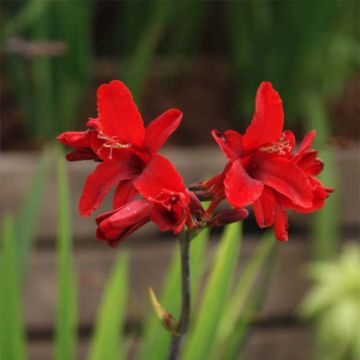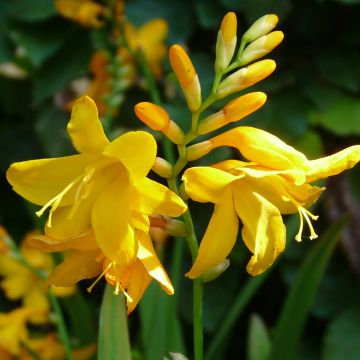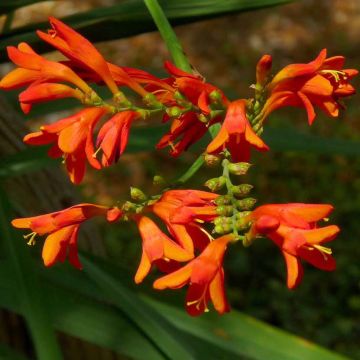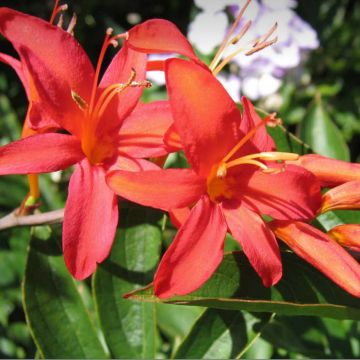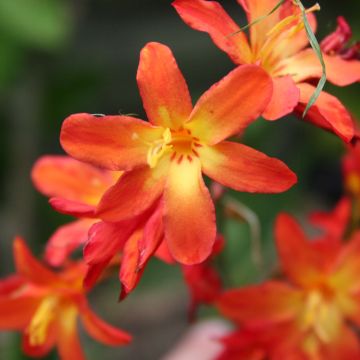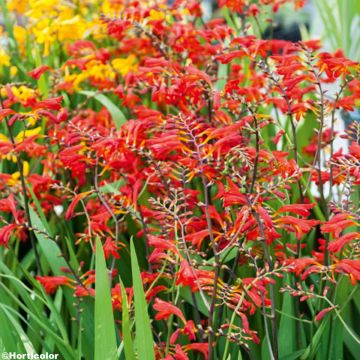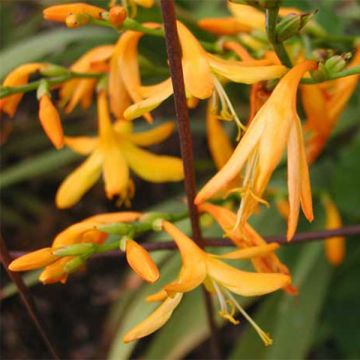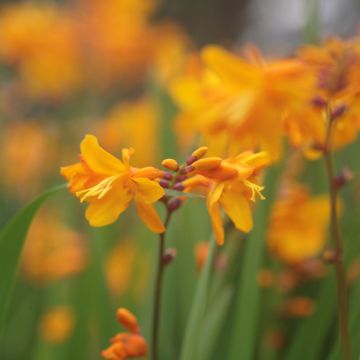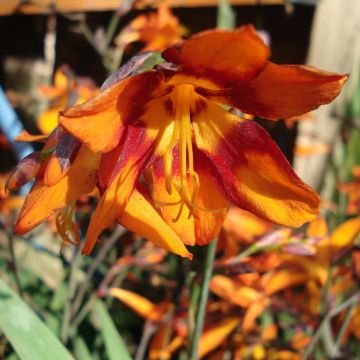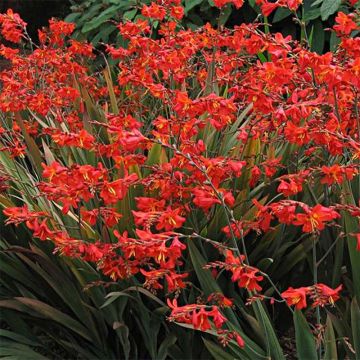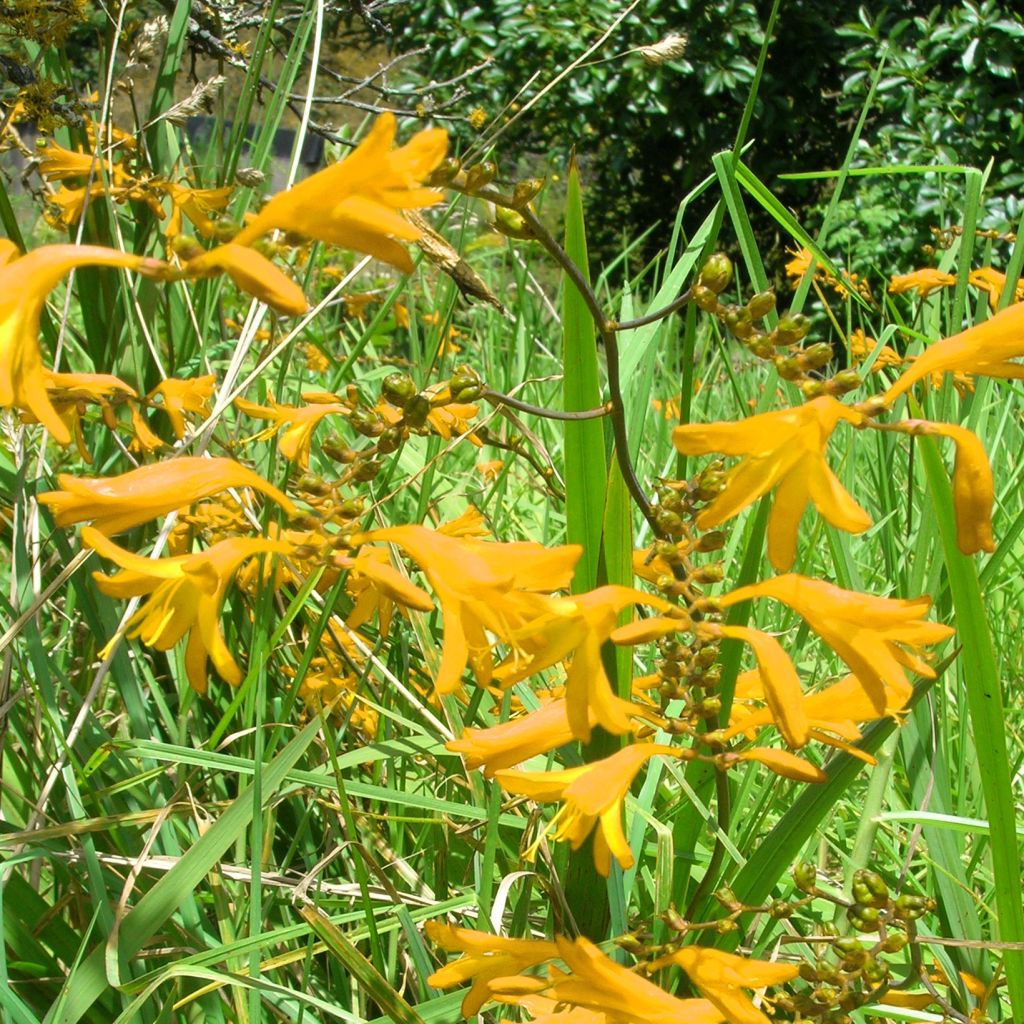

Crocosmia Norwich Canary - Montbretia
Crocosmia Norwich Canary - Montbretia
Crocosmia crocosmiiflora Norwich Canary
Montbretia
I have given you 5 stars for all the plants received because, as usual, they appear to be in very good condition. I have been ordering plants from you for a long time and I have never been disappointed. Best regards.
Martine B., 07/04/2018
This item cannot be shipped to the selected country
Delivery charge from €5.90
More information
Schedule delivery date,
and select date in basket
This plant carries a 6 months recovery warranty
More information
We guarantee the quality of our plants for a full growing cycle, and will replace at our expense any plant that fails to recover under normal climatic and planting conditions.
From €5.90 for pickup delivery and €6.90 for home delivery
Express home delivery from €8.90.
Does this plant fit my garden?
Set up your Plantfit profile →
Description
The Crocosmia crocosmiiflora 'Norwich Canary' is a recent variety of Montbretia, of modest stature but endowed with beautiful vigour, whose abundant light green foliage forms very decorative clumps, even outside of flowering. Its graceful flowers, a light yellow with pale orange reverse, very bright, appear from late July to September, carried by beautifully arched flower stalks. Hybrid Crocosmia multiplies and spreads spontaneously year after year, forming magnificent flowered clusters in summer. Relatively hardy and sun-loving, they do not tolerate poorly drained and moist soils in winter. On the other hand, they require moist soil in summer.
The Crocosmia x crocosmiiflora is a perennial herbaceous plant with corms of South African origin, belonging to the family Iridaceae, obtained in France around 1880. It shows many resemblances with the gladiolus. The 'Norwich Canary' variety, recently obtained in the Netherlands, forms in spring a tuff of basal leaves that are supple, well-furnished, and 40 cm (16in) tall, and produces from July onwards a 60 to 70 cm (24 to 28in) tall arched stem, carrying a horizontally branched spike, with many buds of a beautiful light and vibrant orange, which open into flowers about 3 cm (1in) in diameter, in the shape of narrow trumpet with six petals, well opened. The flower tube is yellow-orange, while its petals are a light yellow, more orange on the reverse. The bright green leaves are in the shape of a narrow sword. Their surface is crumpled and strongly veined, and they spread in a fan or dense cluster from the base of the plant. The reserve organ of the crocosmia is a corm, which means an underground pseudo-bulb that looks like a bulb but is formed by a swollen stem surrounded by scales.
Half-bulb and half-stump montbretias are symbols of summer. Easy to grow, vigorous, and not demanding, they are planted in the sun, in groups of 10 corms, in fertile and moist soil. Their vibrant colours, yellow, orange, or red, form very cheerful spots of colour in gardens. They are splendid when combined with annuals (love-in-a-mist, poppies, cosmos, cleomes) or shrubs, and work well in natural compositions mixed with light perennials (asters, gauras, linarias, shrubby salvias) or grasses. When they are happy in the ground, in sunny exposure and well-drained soil, they multiply over the years and become more beautiful each year. They are also excellent plants for your flower bouquets.
Report an error about the product description
Crocosmia Norwich Canary - Montbretia in pictures
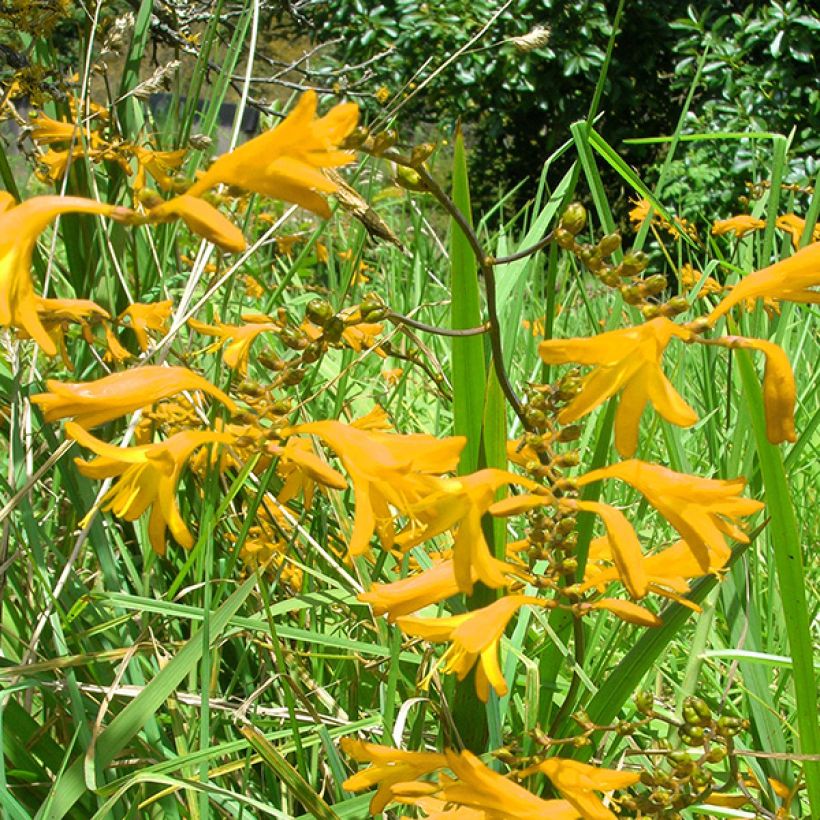

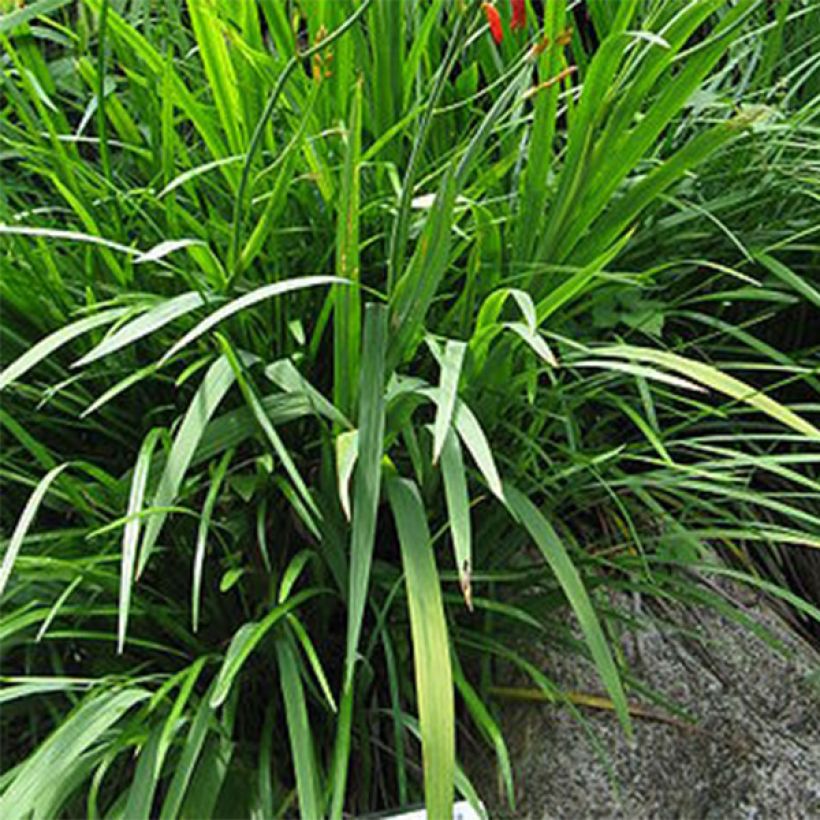

Plant habit
Flowering
Foliage
Botanical data
Crocosmia
crocosmiiflora
Norwich Canary
Iridaceae
Montbretia
Cultivar or hybrid
Other Crocosmia
Planting and care
Plant crocosmias in full sun, preferably in spring. They need a well-drained and airy soil. Work the soil when planting and, if necessary, incorporate some sand. They should be covered with 5 to 8 cm (2 to 3in) of soil and spaced about fifteen cm apart. They like rich soils. Apply fertiliser at the time of planting and renew it every spring. While they prefer well-drained soil for winter, crocosmias need plenty of water during their growing season and cannot tolerate any drought in summer. In regions with harsh winters, it is advisable to remove the corms once the foliage has dried and store them in a frost-free location. Another alternative is to cover the bed with a thick insulating layer at the onset of winter and remove it in March.
Hybrid crocosmias are not plants that thrive in Mediterranean climates, but they do very well in mild climates, which receive rainfall in summer.
Planting period
Intended location
Care
-
, onOrder confirmed
Reply from on Promesse de fleurs
Haven't found what you were looking for?
Hardiness is the lowest winter temperature a plant can endure without suffering serious damage or even dying. However, hardiness is affected by location (a sheltered area, such as a patio), protection (winter cover) and soil type (hardiness is improved by well-drained soil).

Photo Sharing Terms & Conditions
In order to encourage gardeners to interact and share their experiences, Promesse de fleurs offers various media enabling content to be uploaded onto its Site - in particular via the ‘Photo sharing’ module.
The User agrees to refrain from:
- Posting any content that is illegal, prejudicial, insulting, racist, inciteful to hatred, revisionist, contrary to public decency, that infringes on privacy or on the privacy rights of third parties, in particular the publicity rights of persons and goods, intellectual property rights, or the right to privacy.
- Submitting content on behalf of a third party;
- Impersonate the identity of a third party and/or publish any personal information about a third party;
In general, the User undertakes to refrain from any unethical behaviour.
All Content (in particular text, comments, files, images, photos, videos, creative works, etc.), which may be subject to property or intellectual property rights, image or other private rights, shall remain the property of the User, subject to the limited rights granted by the terms of the licence granted by Promesse de fleurs as stated below. Users are at liberty to publish or not to publish such Content on the Site, notably via the ‘Photo Sharing’ facility, and accept that this Content shall be made public and freely accessible, notably on the Internet.
Users further acknowledge, undertake to have ,and guarantee that they hold all necessary rights and permissions to publish such material on the Site, in particular with regard to the legislation in force pertaining to any privacy, property, intellectual property, image, or contractual rights, or rights of any other nature. By publishing such Content on the Site, Users acknowledge accepting full liability as publishers of the Content within the meaning of the law, and grant Promesse de fleurs, free of charge, an inclusive, worldwide licence for the said Content for the entire duration of its publication, including all reproduction, representation, up/downloading, displaying, performing, transmission, and storage rights.
Users also grant permission for their name to be linked to the Content and accept that this link may not always be made available.
By engaging in posting material, Users consent to their Content becoming automatically accessible on the Internet, in particular on other sites and/or blogs and/or web pages of the Promesse de fleurs site, including in particular social pages and the Promesse de fleurs catalogue.
Users may secure the removal of entrusted content free of charge by issuing a simple request via our contact form.
The flowering period indicated on our website applies to countries and regions located in USDA zone 8 (France, the United Kingdom, Ireland, the Netherlands, etc.)
It will vary according to where you live:
- In zones 9 to 10 (Italy, Spain, Greece, etc.), flowering will occur about 2 to 4 weeks earlier.
- In zones 6 to 7 (Germany, Poland, Slovenia, and lower mountainous regions), flowering will be delayed by 2 to 3 weeks.
- In zone 5 (Central Europe, Scandinavia), blooming will be delayed by 3 to 5 weeks.
In temperate climates, pruning of spring-flowering shrubs (forsythia, spireas, etc.) should be done just after flowering.
Pruning of summer-flowering shrubs (Indian Lilac, Perovskia, etc.) can be done in winter or spring.
In cold regions as well as with frost-sensitive plants, avoid pruning too early when severe frosts may still occur.
The planting period indicated on our website applies to countries and regions located in USDA zone 8 (France, United Kingdom, Ireland, Netherlands).
It will vary according to where you live:
- In Mediterranean zones (Marseille, Madrid, Milan, etc.), autumn and winter are the best planting periods.
- In continental zones (Strasbourg, Munich, Vienna, etc.), delay planting by 2 to 3 weeks in spring and bring it forward by 2 to 4 weeks in autumn.
- In mountainous regions (the Alps, Pyrenees, Carpathians, etc.), it is best to plant in late spring (May-June) or late summer (August-September).
The harvesting period indicated on our website applies to countries and regions in USDA zone 8 (France, England, Ireland, the Netherlands).
In colder areas (Scandinavia, Poland, Austria...) fruit and vegetable harvests are likely to be delayed by 3-4 weeks.
In warmer areas (Italy, Spain, Greece, etc.), harvesting will probably take place earlier, depending on weather conditions.
The sowing periods indicated on our website apply to countries and regions within USDA Zone 8 (France, UK, Ireland, Netherlands).
In colder areas (Scandinavia, Poland, Austria...), delay any outdoor sowing by 3-4 weeks, or sow under glass.
In warmer climes (Italy, Spain, Greece, etc.), bring outdoor sowing forward by a few weeks.

































